#530 Aurora Astern
Credit: November 30, 1996
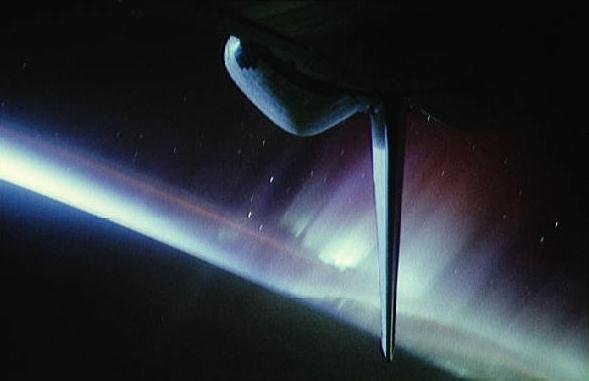
“Sailing upside down, 115 nautical miles above Earth, the crew of the Space Shuttle Endeavour made this spectacular time exposure of the southern aurora (aurora australis) in October of 1994. The aurora, also known as the northern and southern lights, appear as luminous bands or streamers of light which can extend to altitudes of 200 miles. They are typically visible from the Earth's surface at high latitudes and are caused by high energy particles from the Sun. The delicate colors are caused by energetic electrons colliding with oxygen and nitrogen in the atmosphere. In this picture, the rear structure of the Space Shuttle is visible in the foreground with the vertical tail fin pointed toward Earth. Star trails are visible as small streaks above Earth's horizon."
Copyright: Public domain
#531 Star Trails in Northern Skies
Credit and Copyright: December 01, 1996
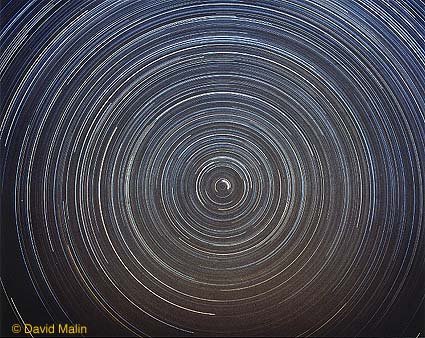
“As the Earth spins on its axis, the sky seems to rotate around us. This motion produces the beautiful concentric arcs traced out by the stars in this time exposure of the night sky. In the middle of the picture is the North Celestial Pole (NCP), easily identified as the point in the sky at the center of all the star trail arcs. The very short bright trail near the NCP was made by the star Polaris, commonly known as the North Star."
Copyright: Public domain
#532 Orion's Star Colors
Credit and Copyright: December 02, 1996
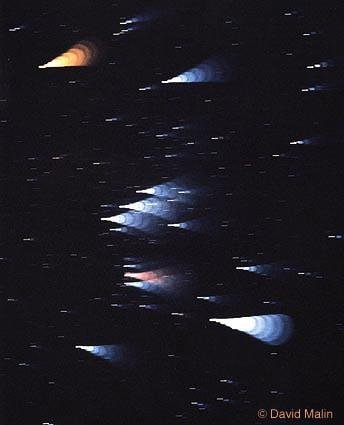
“What determines a star's color? Its temperature. Red stars are cool, with temperatures of around 3,000 kelvins (K), while blue stars are hotter and can have temperatures over 30,000 degrees K. Our own lovely yellow Sun's temperature is a comforting 6,000 K. Differences in star colors are dramatically illustrated in the above photo of the constellation Orion, made using a "star trail step-focus" technique. In this technique, a time exposure is used to create star trails, but during the exposure, the focus is changed in steps. For the brighter stars, the blurred image produces more saturated colors in photographs. At the upper left, the cool red supergiant Betelgeuse stands out from the other, hotter, bluish stars composing the body of the constellation. Bright Rigel, a blue supergiant, is at the lower right."
Copyright: Public domain
#533 Cocoon of a New White Dwarf
Credit: December 03, 1996

“Like a butterfly, a white dwarf star begins its life by casting off a cocoon that enclosed its former self. In this analogy, however, the Sun would be a caterpillar and the ejected shell of gas would become the prettiest of all! The above cocoon, the planetary nebula designated NGC 2440, contains one of the hottest white dwarf stars known. The white dwarf can be seen as the bright dot near the photo's center. Our Sun will eventually become a "white dwarf butterfly", but not for another 5 billion years. The above false color image recently entered the public domain and was post-processed by F. Hamilton. "
Copyright: Public domain
#534 Ice at the Lunar South Pole
Credit: December 04, 1996
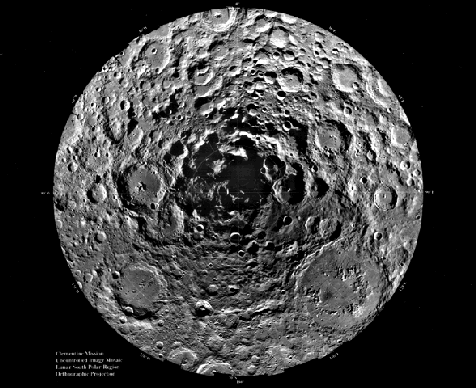
“Ice on the Moon? The prospecting Clementine spacecraft may well have discovered it. In 1994, Clementine spent 70 days in lunar orbit mapping the Moon's surface. Shown above is a dramatically detailed composite view centered on the Lunar South Pole - constructed from 1500 Clementine images. This area contains part of the South Pole-Aitken impact basin, the largest known crater in the solar system, probably caused by the impact of a comet or asteroid. The depth of the basin and crater walls at the Lunar South Pole create the permanent shadow region visible above - hypothesised to be large and cold enough to trap water brought to the moon by cometary impacts as surface ice. Indeed, a recent analysis of Clementine data from this area has found a signature of water ice. Water on the Moon presents exciting possibilities as resource for future lunar exploration."
Copyright: Public domain
#535 Io's Giant Volcano Pele
Credit: December 05, 1996
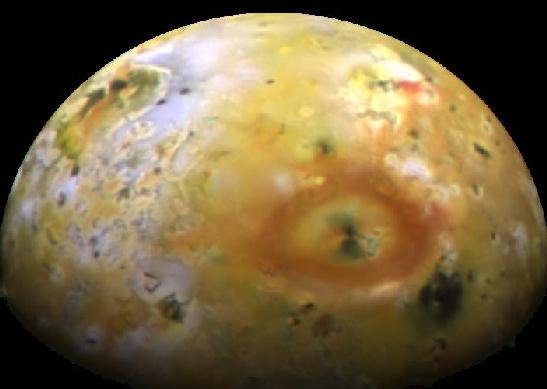
“Io has some very large volcanoes. One of the largest is evident near the center of the above photograph and named Pele, for the mythological Polynesian fire goddess. The Galileo spacecraft now orbiting Jupiter took this picture of Jupiter's most active moon in June, although it was released just last week. Evident around Pele is a large red ring, thought to be evidence of recent volcanic activity. The red color indicates the presence of Sulfur, although how the Sulfur was produced is not precisely known. "
Copyright: Public domain
#536 Globular Cluster M3
Credit and Copyright: December 06, 1996
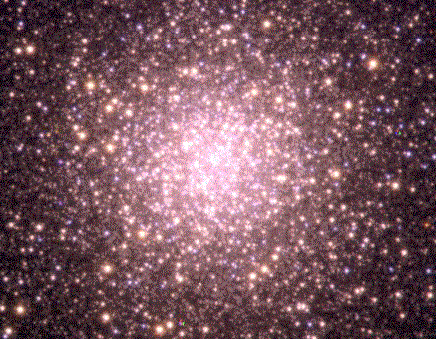
“This huge ball of stars predates our Sun. Long before mankind evolved, before dinosaurs roamed, and even before our Earth existed, ancient globs of stars condensed and orbited a young Milky Way Galaxy. Of the 250 or so globular clusters that survive today, M3 is one of the largest and brightest, easily visible in the Northern hemisphere with binoculars. M3 contains about half a million stars, most of which are old and red. The existence of young blue stars in M3 once posed a mystery, but these blue stragglers are now thought to form via stellar interactions. "
Copyright: Public domain
#537 Planetary Systems Now Forming in Orion
Credit: December 07, 1996
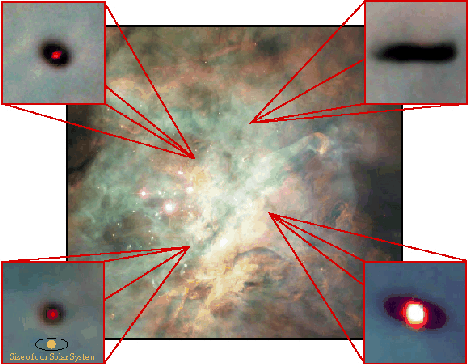
“How do planets form? Astronomers are finding out by studying one of the most interesting of all astronomical nebulae known, the Great Nebula in Orion. Insets to above mosaic show several planetary systems in formation. The bottom left insert shows the relative size of our own Solar System. The Orion Nebula contains many stellar nurseries. These nurseries contain hydrogen gas, hot young stars, proplyds, and stellar jets spewing material at high speeds. Much of the filamentary structure visible in this image are actually shock waves - fronts where fast moving material encounters slow moving gas. Some shock waves are visible near one of the bright stars in the lower left of the picture. The Orion Nebula is located in the same spiral arm of our Galaxy as is our Sun. "
Copyright: Public domain
#538 Degas Ray Crater on Mercury
Credit: December 08, 1996
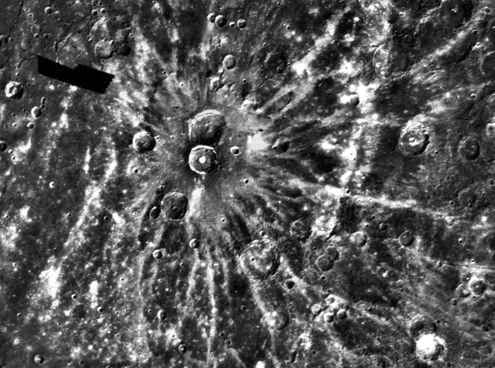
“Like the Earth's Moon, Mercury is scarred with craters, testifying to an intense bombardment during the early history of the Solar System. In 1974, the Mariner 10 spacecraft surveyed this innermost planet up close, producing the only detailed images of its tortured surface. In the above mosaic the bright rays emanating from the 27 mile wide Degas crater almost appear to be painted on. The rays consist of light colored material blasted out during the crater's formation. Numerous smaller, younger craters are seen superposed on the Degas crater itself."
Copyright: Public domain
#539 Callisto Full Face
Credit: December 09, 1996
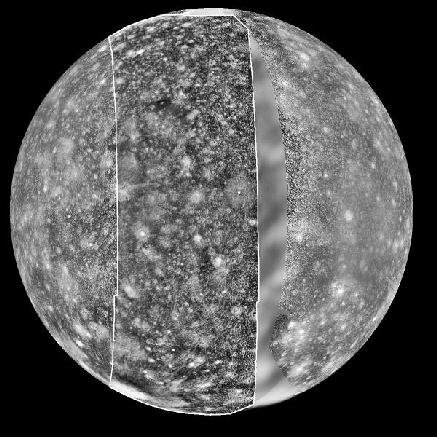
“Callisto's surface shows its age. While probably formed at the same time as Io, the difference between the surfaces of these two moons of Jupiter could hardly be greater. Io's surface is young, shows practically no impact craters, and is continually being repaved by the lava exploding from its many large volcanoes. Callisto's surface is old, shows the highest density of impact craters in the Solar System, and harbors no volcanoes or even any large mountains. Callisto's surface is one large ice-field, laced with cracks and craters from billions of years of collisions with interplanetary debris. The high-resolution vertical band in the above mosaic was taken by the robot spacecraft Galileo currently orbiting Jupiter. The rest of the mosaic was compiled from pictures taken by the Voyager spacecraft which passed the Callisto in 1979. "
Copyright: Public domain
Upvote! Resteem! Comment! As you like it! Thank you for attention!